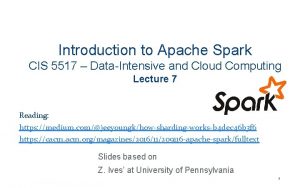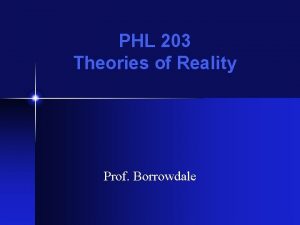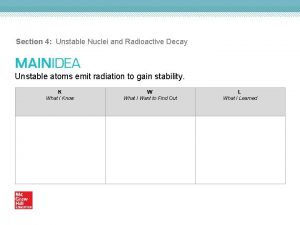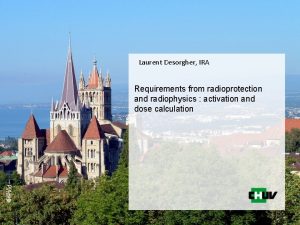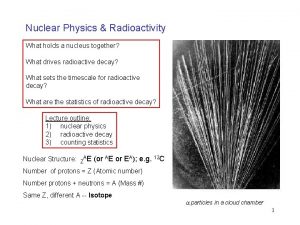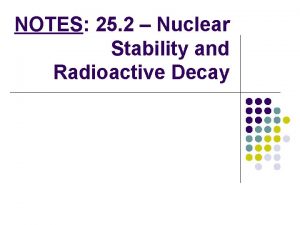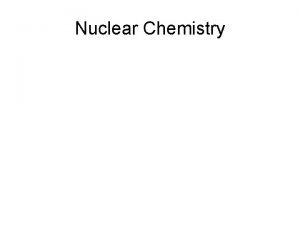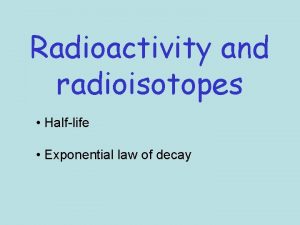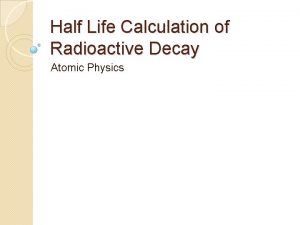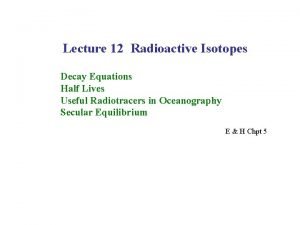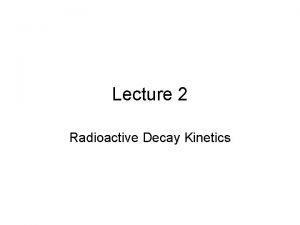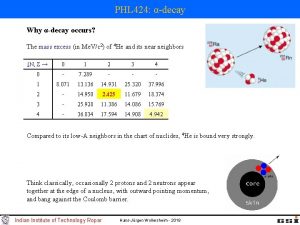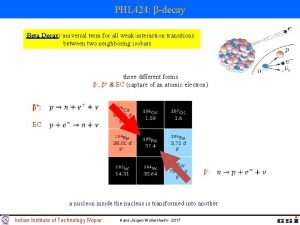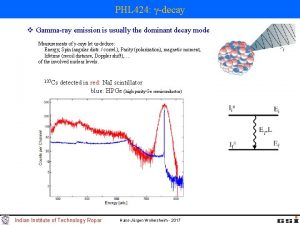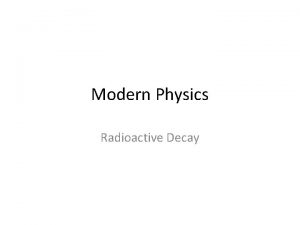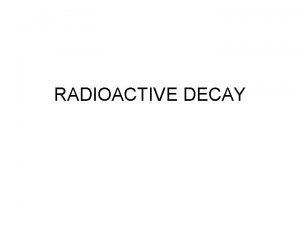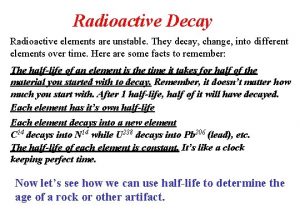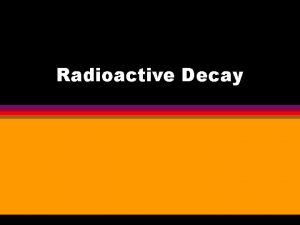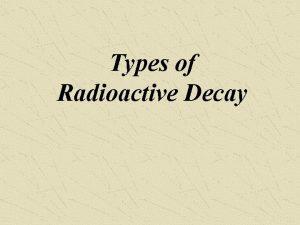PHL 424 Radioactive decay Radioactive Decay is the











![Radiation protection range in air [m] radioactive source Al Pb concrete α´s β´s X-rays Radiation protection range in air [m] radioactive source Al Pb concrete α´s β´s X-rays](https://slidetodoc.com/presentation_image_h2/43720cf113a608af22e6ff921da2f9cf/image-12.jpg)

- Slides: 13

PHL 424: Radioactive decay Radioactive Decay: is the process by which a nucleus of an unstable atom decreases its total energy by spontaneously emitting radiation. • • Discovered in 1897 by the French scientist Henri Becquerel. He place various phosphorescent salts on photographic plates and noticed that only uranium salts exposed the plates. Henri Becquerel Indian Institute of Technology Ropar Hans-Jürgen Wollersheim - 2017

Characterization of radioactive material Marie Curie Henri Becquerel’s discovery inspired Marie and Pierre Curie to investigate the phenomena further. • They found that the mineral pitchblende was more active than uranium, and concluded that it must contain different radioactive substances • From this, they discovered polonium and radium, both of them more radioactive than uranium. Indian Institute of Technology Ropar Hans-Jürgen Wollersheim - 2017

Successful investigations of radioactivity Indian Institute of Technology Ropar Hans-Jürgen Wollersheim - 2017

Primary modes of radioactive decay Indian Institute of Technology Ropar Hans-Jürgen Wollersheim - 2017

Primary modes of radioactive decay chart of nuclides: -representation of isotopes in the Z-N plane proton number Z -isotope: atom (nucleus) of an element with different number of neutrons different modes of radioactive decay neutron number N Indian Institute of Technology Ropar Hans-Jürgen Wollersheim - 2017

The radioactive decay law The number of nuclei that decay is proportional to the number of radioactive nuclei N in the sample: λ is the decay constant • Radioactivity is an exponential decay process • The sample activity or decay rate is given by • The lifetime and the half-life is defined as Indian Institute of Technology Ropar Hans-Jürgen Wollersheim - 2017

Nuclear decay Indian Institute of Technology Ropar Hans-Jürgen Wollersheim - 2017

Nuclear decay with branching v The initial nucleus can decay into either of two products, e. g. in a sample of 212 Bi, 36% of the nuclei decay to 208 Tl and 64% to 212 Po. 36% Consider the case A → B and A → C in parallel. We have for all time t: which is constant, since the total number of nuclides remain constant. Differentiating with respect to time: Definition of the branching ratio: Indian Institute of Technology Ropar Hans-Jürgen Wollersheim - 2017 64%

Activity v For lifetimes comparable or longer than the span of a human life there are no measurable changes in the activity of a sample which prohibits direct decay curve measurements. In these cases the decay rates λ are deduced from the ratio of the observed activity A to the absolute number of radioactive atoms N in a sample. with the molar mass μ and the Avogadro number NA v For example 1 MBq of tritium (3 H, T 1/2=12. 33 [y]) corresponds to 5. 59· 1014 atoms or 2. 78 [ng] of mass. v 1 MBq of 14 C (T 1/2=5730 [y]) corresponds to 2. 6· 1017 atoms or 6 [μg] of mass. Indian Institute of Technology Ropar Hans-Jürgen Wollersheim - 2017

Activity The number of radioactive nuclei is often unknown. One can only measure the number of decays per second (decay rate). This is the reason why the activity is defined as the number of decays per second: number of decays per second 1 Becquerel (Bq) = 1 decay/s time When at the beginning N(t=0) radioactive nuclei were present, then the activity A after the time t is given by Indian Institute of Technology Ropar Hans-Jürgen Wollersheim - 2017

Activity at the beginning: Activity at time t: Activity at time 2 t: Activity at time 3 t: General expression: Example: The activity of a sample was measured 1000 [Bq] one hour ago. The present activity is 900 [Bq]. What is the activity in one hour? Indian Institute of Technology Ropar Hans-Jürgen Wollersheim - 2017
![Radiation protection range in air m radioactive source Al Pb concrete αs βs Xrays Radiation protection range in air [m] radioactive source Al Pb concrete α´s β´s X-rays](https://slidetodoc.com/presentation_image_h2/43720cf113a608af22e6ff921da2f9cf/image-12.jpg)
Radiation protection range in air [m] radioactive source Al Pb concrete α´s β´s X-rays γ-rays neutrons Indian Institute of Technology Ropar Hans-Jürgen Wollersheim - 2017

Radiation protection The biological dose, sometimes also known as the dose equivalent is expressed in units of Sieverts [Sv]. This dose reflects the fact that the biological damage caused by a particle depends not only on the total energy deposited but also on the rate of energy loss per unit distance traversed by the particle. equivalent dose = energy dose · quality factor Q Indian Institute of Technology Ropar Hans-Jürgen Wollersheim - 2017 radiation quality factor Q X-ray, γ, β 1 thermal neutrons 2. 3 fast neutrons 10 α-particles, heavy ions 20
 Phl to rdd
Phl to rdd Phl moodle
Phl moodle How unstable atoms gain stability
How unstable atoms gain stability Calculation of radioactive decay
Calculation of radioactive decay Law of radioactive decay
Law of radioactive decay Radioactive decay law
Radioactive decay law Type of radioactive decay
Type of radioactive decay Radioactive decay
Radioactive decay Type of radioactive decay
Type of radioactive decay Exponential decay law
Exponential decay law Half life
Half life Radioactive decay formula
Radioactive decay formula How to calculate radioactive decay
How to calculate radioactive decay Exponential decay
Exponential decay
